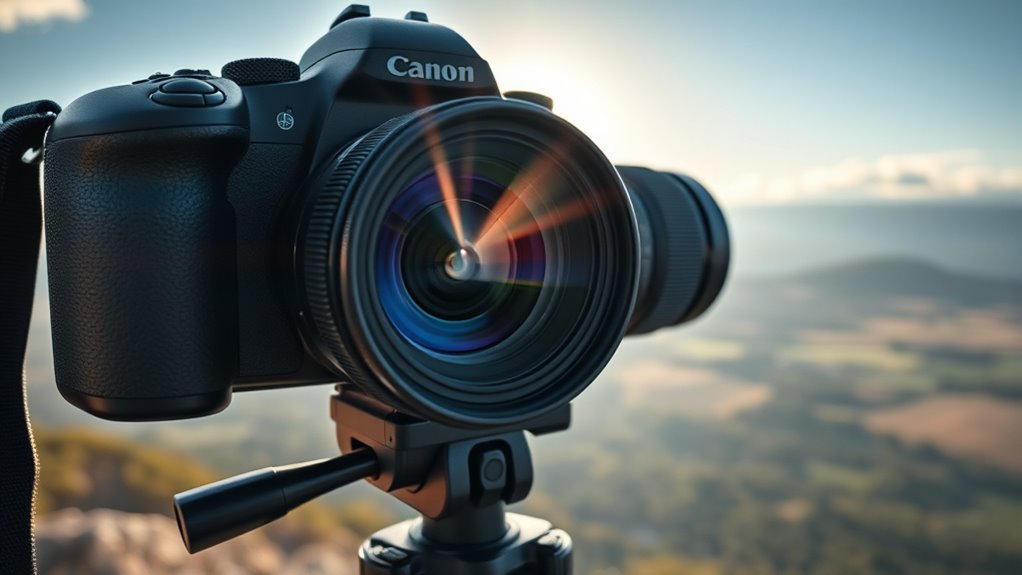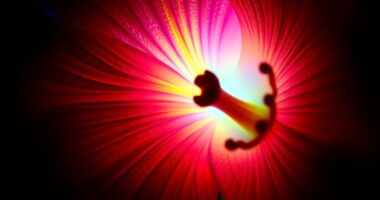Sensor crop factor affects how your lens performs regarding light gathering and field of view. When you use a lens on a smaller sensor camera, it acts like a longer focal length, narrowing your perspective. To get the exact framing you want, multiply your lens focal length by the crop factor. This math helps you understand how sensor size influences your photos, and exploring more will give you even better control over your images.
Key Takeaways
- Sensor crop factor adjusts the effective focal length, affecting light gathering and how lenses behave on different sensors.
- Calculating the effective focal length involves multiplying the lens focal length by the crop factor, altering the field of view.
- Smaller sensors produce more zoomed-in images, requiring focal length adjustments to achieve desired framing and perspective.
- Crop factor influences light capture, which impacts exposure, depth of field, and overall image quality, especially in low-light conditions.
- Understanding crop factor helps compare camera systems, select appropriate lenses, and predict the actual field of view for compositions.

Understanding sensor crop factor is essential if you want to accurately evaluate your camera’s field of view. The sensor crop factor, sometimes called the crop multiplier, influences how lenses behave on different cameras. When you attach a lens to a camera with a smaller sensor, the image captured isn’t exactly the same as it would be on a full-frame sensor. Instead, it appears more zoomed-in, which can affect composition and framing. To compensate, you need to consider focal length adjustment, which involves multiplying the lens’s focal length by the crop factor. For example, if you’re using a 50mm lens on a camera with a crop factor of 1.5, the effective focal length becomes 75mm. This means your field of view is narrower, similar to what you’d see through a 75mm lens on a full-frame camera.
Understanding crop factor helps you adjust focal lengths for accurate framing on different camera sensors.
Understanding this concept helps you plan your shots better. If you’re aiming for a wide-angle perspective, knowing your sensor crop factor allows you to select a lens with a shorter focal length or adjust your expectations accordingly. It’s not just about numbers; it’s about how the sensor size impacts the amount of light captured and the resulting image. Recognizing this, you can adjust your camera settings or lens choices to maintain the desired exposure and aesthetic. Additionally, smaller sensors gather less light than full-frame sensors, which can influence exposure, depth of field, and overall image quality.
When you’re switching between different camera systems, keeping the sensor crop factor in mind becomes vital. It’s easy to assume a lens will give the same field of view across various cameras, but that’s not the case without focal length adjustment. For instance, a 24mm lens on a crop-sensor camera with a crop factor of 1.5 will give you a field of view similar to a 36mm lens on a full-frame. If you want to replicate the wide-angle view of a 24mm lens, you’ll need to use a lens with a shorter focal length or accept the narrower crop view.
In practical terms, understanding the sensor crop factor helps you make smarter lens choices and set realistic expectations. Whether you’re shooting landscapes, portraits, or macro, knowing how the sensor size affects your camera’s field of view ensures you’re not surprised by the outcome. It also makes it easier to compare equipment and understand camera specifications, ultimately giving you more control over your photography. By mastering focal length adjustment in relation to sensor crop factor, you can better visualize your shots and plan compositions that fit your creative vision.
Frequently Asked Questions
How Does Sensor Crop Factor Affect Low-Light Photography?
Sensor crop factor impacts your low-light photography by influencing how much light your camera sensor captures. A smaller sensor size usually has reduced light sensitivity, making it harder to shoot in dim conditions without noise or blur. This means you might need to use wider apertures, higher ISO, or longer exposures. Understanding crop factor helps you adjust settings accordingly, ensuring you get clearer, better-exposed shots even in challenging low-light situations.
Can Crop Factor Influence Depth of Field in My Images?
You might think crop factor influences depth of field, but it actually depends on your sensor size and aperture effects. A smaller sensor, like in crop cameras, naturally increases depth of field, making backgrounds appear more in focus. If you use the same aperture and framing, your images will have a different depth of field compared to full-frame cameras. So, crop factor indirectly impacts depth of field through sensor size and aperture choices.
What Are the Best Lenses for Crop Sensor Cameras?
When choosing lenses for your crop sensor camera, look for lens compatibility to guarantee a perfect fit. Crop sensor cameras offer advantages like smaller, lighter lenses and cost-effective options. Popular choices include standard zooms and wide-angle lenses that maximize your camera’s crop factor for creative framing. These lenses help you take full advantage of your camera’s capabilities, making it easier to capture sharp, vibrant images across various genres.
How Does Crop Factor Impact Image Stabilization Effectiveness?
Crop factor affects how effective image stabilization (IS) is because it impacts your sensor size and lens compatibility. When using a crop sensor, stabilization may seem less effective since the smaller sensor amplifies movement, requiring more stabilization. You’ll need to choose lenses with built-in IS or compatible stabilization systems carefully. Keep in mind, crop sensors often need different stabilization settings to maintain sharp images at various focal lengths.
Are There Specific Camera Brands Better Suited for Crop Sensors?
Think of choosing a camera brand like finding a perfect dance partner. When considering sensor compatibility, some brands naturally harmonize better with crop sensors, offering better autofocus and lens options. Brands like Canon, Nikon, and Sony each have their strengths, making them more suited for crop sensors. Your choice depends on your style and needs, but these brands often lead in compatibility and performance, making your photography dance smooth and effortless.
Conclusion
Understanding sensor crop factor helps you choose the right lens and framing, ensuring your photos turn out just how you want. Remember, it’s like knowing the secret handshake of your camera’s sensor—without it, you’re flying blind. So, take this knowledge and wield it like a Jedi with a lightsaber. With a little practice, you’ll be capturing stunning shots in no time—no need to be a wizard, just a savvy shutterbug in this digital age.









